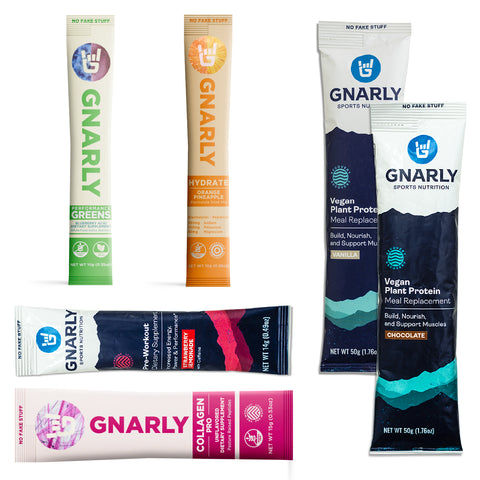There is a lot of speculation regarding proper race day hydration and fueling, and in truth, the optimal strategy for you is likely to be quite different than the runner next to you. Given that, there are some basic hydration and fueling strategies for before, during and after your run, that if you’re not already doing, will definitely help on race day.
Hydration
Let’s talk hydration. An effective hydration strategy will replace what is lost in sweat, so run hydration should be about both fluid and electrolyte replacement. To determine how much you should drink you need to determine your sweat rate or the amount of water lost via sweat in a given amount of time (typically an hour). For the specifics on how to effectively do a sweat test. When measuring sweat rate, it’s important to replicate the conditions you will experience on race day as closely as possible as things like running intensity, temperature and humidity can all affect the amount you sweat.
Taking in the right amount of water will get you halfway to properly hydrating, but if that is all you do, then your performance will suffer and you could seriously injure yourself. The other half of the equation involves replenishing the electrolytes lost in sweat. There are a ton of electrolyte replacement products on the market and wading your way through label claims and nutrition facts panels can be confusing. Here’s what you should keep in mind when choosing an electrolyte drink: Although sodium, potassium, calcium and magnesium are all lost in sweat, sodium is, by far, lost in the greatest concentrations, with losses ranging from 200-700mg per 16 oz of sweat. Therefore you should look for an electrolyte beverage that contains a significant amount of sodium and to a lesser extent potassium, calcium and magnesium. This is precisely why, although delicious, coconut water is not an effective electrolyte replacement beverage for athletes, containing ample potassium, but very little sodium. By choosing a hydration beverage that contains electrolytes at effective levels, you ensure you’re giving your body both the water and electrolytes it needs to perform optimally, while preventing cramping and dehydration.
No matter the distance, being properly hydrated at the starting line is integral to a successful race. Aim to take in 16-24 oz of your chosen electrolyte drink, 2-3 hours before your race start. If your race or training run is under 90 minutes, you will likely not have to rehydrate during your run, but using thirst as your ultimate guide is recommended. If your race is over 90 minutes, stay consistent with your hydration strategy throughout your run, taking in fluid every 20-30 minutes, as opposed to drinking large quantities of fluid at a single time point.

Finally, when you’ve finished your race and are basking in the glory of accomplishment, aim to consume 16-18 oz of an electrolyte replacement drink as this will significantly aid in recovery from your effort.
Fueling
As you gradually build to match the distance of your race, you should also train for how to fuel your body during that distance. This includes fueling before, during and after your training efforts. Your body generally stores enough energy, in the form of glycogen, to keep you fueled for runs up to 90 minutes, so if you plan on being out for less than 90 minutes you may not need to consume extra calories. Running in the morning on an empty stomach, however, complicates things as you will be running after an overnight fast and energy stores, specifically liver glycogen, will be depleted. So, if your stomach can handle it in the early morning, eat 100-160 calories (25-40g) of easily digestible carbohydrates (e.g., one banana) 30-60 minutes before your run. And if you have more time, plan on consuming 300-400 calories in the 2-3 hours before your effort or race; this meal can contain a mixture of complex and simple carbs, but also a little protein and fat (e.g. oatmeal w/ banana, almond butter and maple syrup).
If your training run or race is under 90 minutes and you fuel and hydrate properly beforehand, you will not necessarily need to take in any more calories or fluid while you’re running.
If you are training for a longer effort, like a half marathon however, it will be key to use your longer training runs to practice consistent fueling and hydration. Additionally, it’s always a good idea to know what food and hydration products will be offered at aid stations on the course and, if possible, train with those products; this information is usually available on race websites. During longer efforts, get on a consistent fueling schedule by setting your watch timer for 20-30 minute intervals at which you take in calories and hydrate; you can either use this same strategy during your race or just plan on stopping at regularly spaced aid stations. Practicing race day nutrition during your training will also allow you to fine tune the amount and type of calories your body can handle while running. You should generally aim on consuming 120-240 calories (30-60g of carbs) per hour of running. Gnarly Fuel20 is a great option that meets both your calorie and electrolyte needs.
Recovery
Athletes often get caught up in the distracting excitement and satisfaction of reaching the finish line and consequently often neglect post-race nutrition. Refueling and rehydrating after a race can significantly decrease muscle soreness and reduce recovery time. To realize these benefits, aim for consuming between 60-80g of carbohydrate and 15-20g of protein within 30-60 minutes of completing your run. Taking in sufficient carbohydrates will replenish glycogen stores, while protein intake will reduce exercise-induced muscle damage, build new muscle and lower levels of the stress hormone cortisol. Timing is everything, so if you don’t have a post-race meal prepared in advance or you’re far away from your kitchen, consider a protein shake added to milk or juice to get the nutrients you need quickly and conveniently. Doing so will also help with fluids lost during your effort. The ultimate rehydration goal, however, should be consuming 16-18 oz of an electrolyte replacement drink within 2 hrs of finishing the run.
Good nutrition practices lay the groundwork for a healthy body and set the stage for optimal performance. Start experimenting with these basic principles during your training and learn what works best for you. If you haven’t been doing what’s suggested above, don’t sweat it (pun intended), pick a couple of things to work on and you will soon realize the benefits.

BUY HERE and get free shipping




